Stuck staring at your blank sketchbook? Try drawing everyday objects—like a tangled pair of earbuds or a mug with a chipped handle. Plants and flowers make great practice for textures, while wild patterns or abstract shapes let imaginations stretch. Challenge yourself with quick portraits of family, or mash up animals to invent something totally new. Food, funny angles, and rainy-day scenes add fun variety. There’s a world of ideas waiting—just flip the page to discover more.
Key Takeaways
- Sketch everyday objects like mugs, keys, or fruit to practice observing shapes, textures, and shadows.
- Draw plants and florals to explore detailed botanical forms and develop your shading techniques.
- Challenge yourself with portraits or animal studies from photographs or life to capture expressions and textures.
- Create geometric patterns, abstract designs, or Zentangle-inspired art for relaxing, repetitive sketching.
- Illustrate favorite foods or dining setups, focusing on textures, reflections, and dynamic arrangements for lively compositions.
Draw Everyday Objects From Life
Although drawing wild animals or epic scenery sounds cool, sometimes the best place to start is right in your own kitchen—or even at your messy desk.
Drawing from life might seem boring at first glance, but grab a pencil and things get interesting fast. Everyday objects, like a half-eaten apple, a crumpled soda can, or your favorite mug, are perfect for filling a sketchbook page.
Focusing on these items helps artists notice tiny details, the weird shadows, and even the quirky textures. Suddenly, that paperclip looks epic!
Zooming in on everyday things reveals hidden patterns, odd shadows, and unique textures—suddenly, even a paperclip becomes fascinating.
Plus, working with familiar objects can help calm nerves, especially for those nervous about drawing outside. Trying different tools or adding colors makes things more fun and personal. Each object, no matter how ordinary, holds exciting possibilities.
Sketch Plants and Florals

Sketching plants and florals is like trying to catch a leaf before it falls—full of tricky little details and surprises.
Focusing on all those twists in a vine or crinkles in a petal helps artists spot what makes each plant special, while playing with different flower groupings can lead to some wild and beautiful arrangements.
It’s a chance to explore shapes and patterns from nature, and maybe even mix in a few doodles of your own for extra personality.
Capturing Botanical Details
Whenever someone picks up a pencil to draw a plant or a bunch of flowers, there’s a sort of magic that happens—they start to see a hidden world of twisty stems, crinkled leaves, and spots that no one really notices at first.
Maybe on that first page, they’ll realize a leaf isn’t just green—there are holes, ribbed veins, maybe even a bug munching the edge! If they find reference photos or real plants, it helps capture those funky flaws, but they shouldn’t feel like they need to copy every detail perfectly.
Mess around with soft pencils, charcoal, or whatever’s handy to bring out rich shadows and weird textures. Mixing quick thumbnails with loose sketches makes every botanical drawing an adventure, not a science project.
Exploring Flower Compositions
Bouquets and plant pots aren’t just for brightening up rooms—they’re secret training grounds for anyone with a pencil and a love of doodling.
Seriously, grab a page and try drawing from life! There are lots of different ways flowers and leaves cluster, droop, or pop out from a vase, so don’t just stick to one version. Mix it up.
Sketch tiny thumbnail layouts of different flower arrangements before starting your big, dramatic masterpiece. This lets you experiment without erasing holes in your page.
Use soft and hard pencils for lines and petals, playing with light and dark shading where the sun hits or shadows gather.
And remember: those weird leaves or wobbly pots? They give your drawing character, making your florals look super fresh and real.
Capture Scenes From a Window
Even the most familiar window can turn into an adventure waiting to happen, just by grabbing a pencil and looking outside. A window sill is a great place to start if you want to capture something new every day; just pay attention to the ever-changing light and activity. Take your time noticing how shadows shift, or how a bird swoops by in a hurry. The window frame acts like a picture frame—use it! Including a plant or a chair in your drawing adds personality. Quick sketches help you capture surprising moments, like a neighbor waving or rain racing down the glass. Look at the table below for some inspiration on what changes outside your window:
| Time of Day | Things to Notice |
|---|---|
| Morning | Soft light, dew on grass |
| Noon | Bright sun, busy streets |
| Afternoon | Long shadows, golden hue |
| Evening | Sunset, streetlights glow |
| Night | Reflections, quiet roads |
Explore Geometric Shapes and Abstract Designs

How do circles, triangles, and squares suddenly become a universe of cool designs? That’s the magic of mixing geometric shapes and abstract designs on paper!
Starting with a simple circle or crisp square, anyone can fill their sketchbook with wild patterns and creative doodles. Try using a ruler or compass to nail those sharp angles and perfect curves—precision makes everything pop.
Some artists even break out zentangle techniques, drawing intricate patterns inside each shape until the page practically vibrates with energy. Shading adds major drama; by darkening certain areas and lightening others, sketches gain awesome depth and texture.
Vary your line weights too—thick, thin, bold, or delicate lines all have a place. Suddenly, shapes are more than shapes—they’re art with attitude.
Practice Portraits of Friends or Family
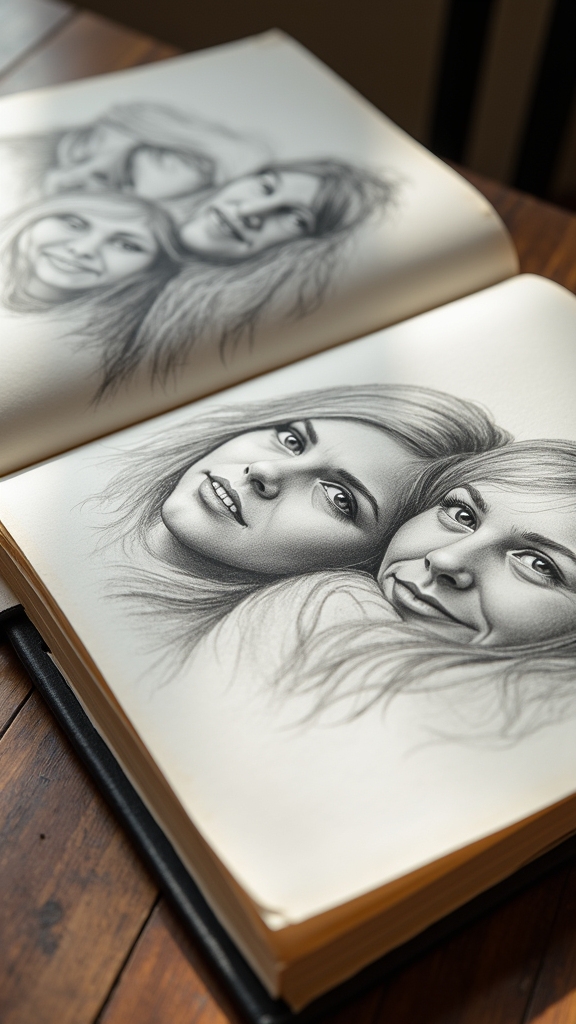
Drawing portraits of friends or family is a real test of skill, because capturing their one-of-a-kind expressions can be equal parts tricky and awesome.
Using reference photos takes away a lot of guesswork with tricky faces and lets you focus on the details, whether someone is giving you a cheesy grin or a totally mysterious look.
Try sketching from weird angles too—sometimes a superhero chin or a wild top-down selfie makes a portrait way more fun (and your family will definitely have opinions about your “creative” choices).
Capturing Unique Expressions
While it might seem like everyone’s face is the same at a quick glance, each person actually has their own totally unique set of expressions that make drawing portraits super fun and challenging.
It’s almost like a secret language hidden in tiny shifts of eyebrows, eyes, or mouth. When someone’s really laughing or deep in thought, their whole face changes. Focusing on these little details helps artists capture what makes their subject special.
Using techniques like hatching and cross-hatching can add so much depth, making those expressions almost pop off the page. Switching up pencil pressure gives different shades and adds drama, too.
Sketching friends or family in a bunch of different moods is a great way to practice—and sometimes, the goofier the face, the better!
Working From Reference Photos
Sometimes, all it takes is one awesome reference photo to totally level up a pencil portrait. When someone picks a photo of a friend or family member, it’s like revealing a superpower for nailing those tricky facial features and expressions.
Using high-quality reference photos means the proportions—like the distance between the eyes or the curve of a smile—come out way more accurate. Some artists like to grid out their paper, matching sections to the photo to double-check spacing.
Shading is also where the real magic happens. By carefully watching shadows in the reference photo, each pencil mark brings depth and texture to hair, skin, and even that one wild shirt.
Regular practice with different photos helps anyone catch every unique personality, one sketch at a time.
Exploring Different Angles
After getting the hang of working with reference photos, it’s time to get creative with fresh perspectives—literally.
Exploring different angles when sketching portraits of friends or family can make your drawings way more interesting. Imagine you’ve been drawing the same face—front view, maybe a slight smile. Boring, right? Challenge yourself by snapping reference pics from above, below, or even from behind as someone laughs at a joke.
Lighting adds drama, whether it’s the moody dusk light or a sunny kitchen window. If you want everyone to look human (not like lopsided potatoes), try using the grid method for those tricky angles.
Here are some fun ways to level up your angle game:
- Capture silly expressions from odd angles
- Sketch during different times of day
- Draw while your subject is busy
Study Your Favorite Animal
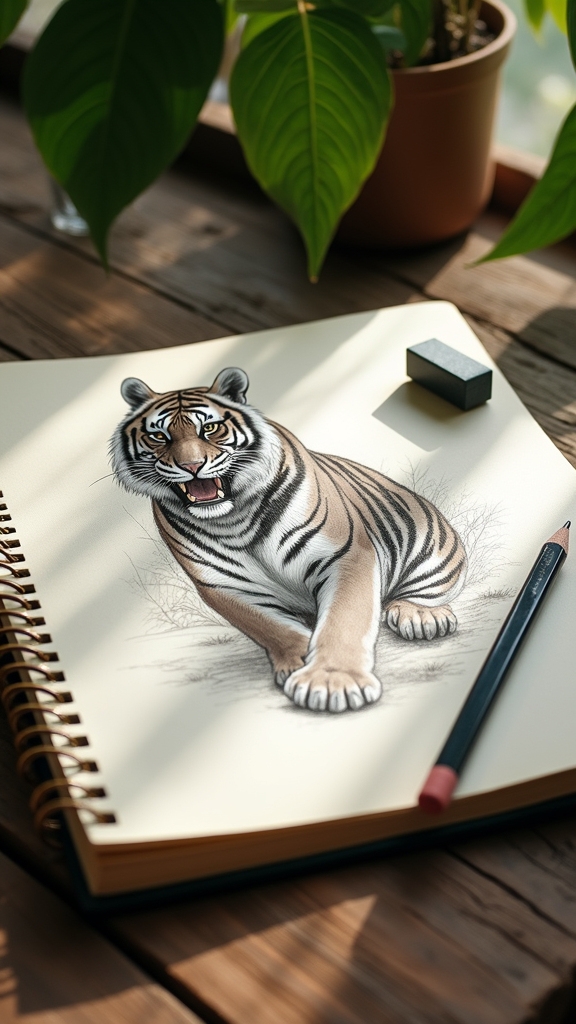
Favorite animals aren’t just cool to look at—they’re awesome sketching subjects, too. If you’ve ever thought, “Next time, I simply have to draw that lion/cat/parrot,” you’re in good company!
Anyone who says, “I’ve been drawing animals forever,” knows there’s always something new to notice. Start by really watching your favorite animal—pay attention to their positions, quirky expressions, and the way their fur or feathers catch the light.
No matter how often you draw animals, there’s always a fresh detail to discover when you truly observe them.
Reference images, like wildlife documentaries or photos, can be super helpful. Try drawing close-ups: eyes, paws, or maybe that wild, fluffy tail.
Play with pencil techniques like cross-hatching for depth. Make a whole series and tell a story about where your animal lives or how it acts—epic adventure, sketchbook style!
Create Still Life Arrangements
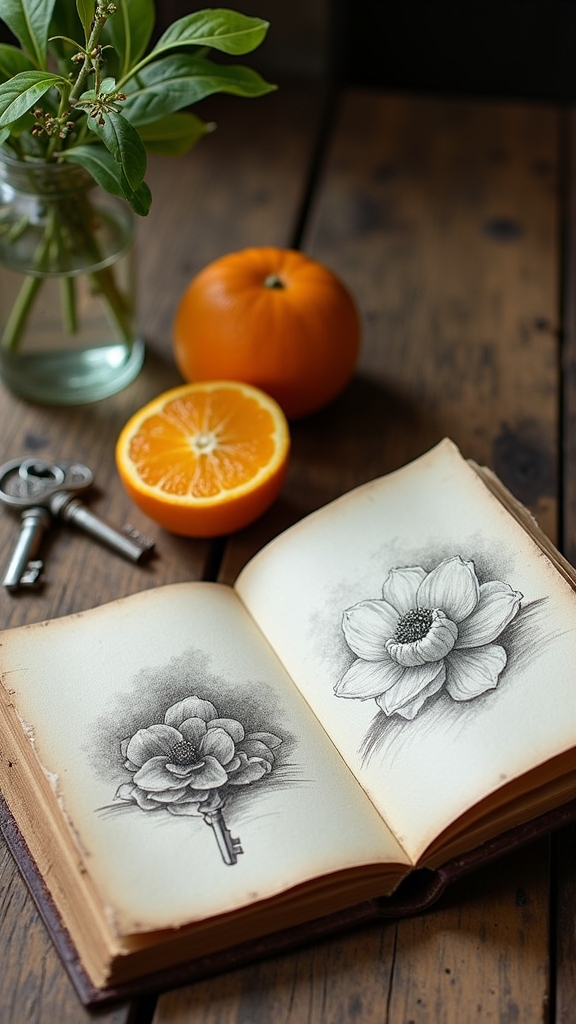
Sketching animals is wild and full of surprises, but sometimes it’s fun to set the stage and be in total control. That’s where still life arrangements come in—grabbing everyday objects like apples, mugs, or even sunglasses, and arranging them however you want.
It gives you time to really look at shapes, explore shadows, and play with texture. Arrange a lot of things or just a few; mix up the items as you go. Natural light will show off the best highlights and shadows, turning even an orange into a masterpiece.
Thanks so much, still life, for helping artists practice observation skills and new techniques!
- Try mixing glass, metal, or ceramic objects for cool texture challenges
- Use side or top-down angles for different vibes
- Stick to just pencil—no color needed!
Reimagine Book Covers or Album Art
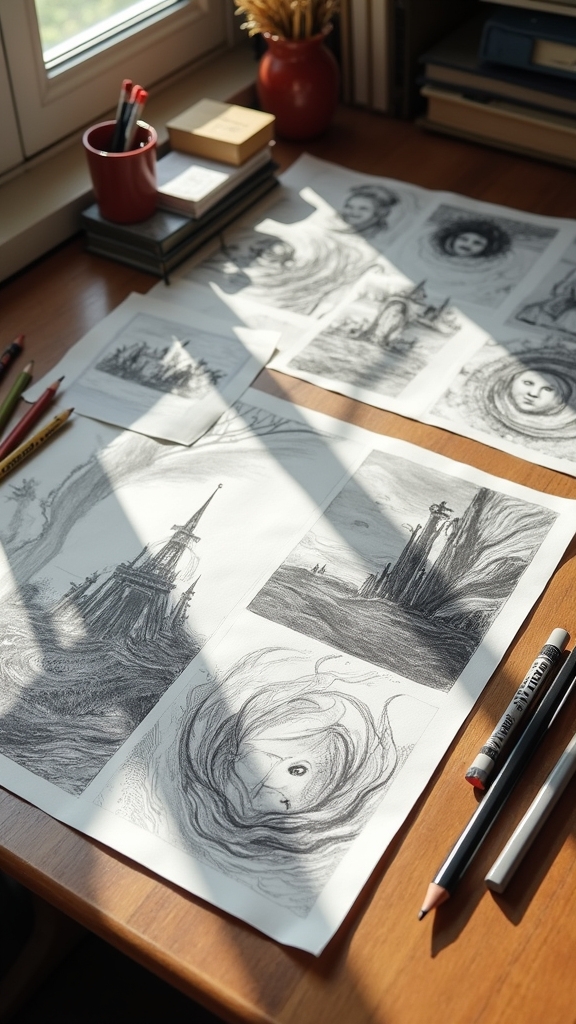
When a book or album has an awesome cover, it almost begs for a creative remix. Sometimes, I’m looking at my favorite book and thinking, “I’m going to try sketching this in my own style!”
Reimagining book covers or album art is a perfect way to flex some creative muscle. Grab that novel you love or an album you blast all the time, then break down the colors, images, and mood.
Try thumbnails first—tiny sketches that help you test wild new layouts without spending a ton of time. Mix it up: charcoal for drama, colored pencils for a pop, or shade with graphite to keep things classic.
Add patterns or textures to make your redesign unique, reflecting what you feel, not just what you see.
Experiment With Pattern and Repetition
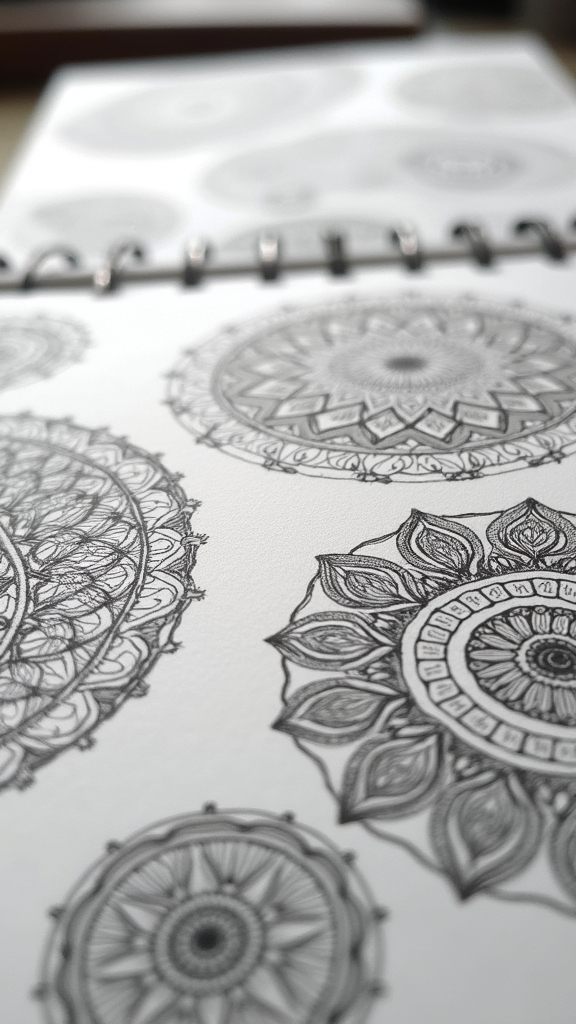
Patterns can totally transform a sketch, whether you’re making seamless repeating designs, playing with zentangle techniques, or mixing in different motifs for some extra flair.
There’s something strangely satisfying about watching simple shapes link up into a wild, hypnotic pattern across the page—almost like a brain teaser for your pencil.
Trying out these ideas isn’t just fun, it’s a cool way to see how repetition can make even doodles look next-level.
Creating Seamless Repeating Patterns
There’s something almost magical about seamless repeating patterns—they can turn a single doodle into a wild wallpaper that just keeps going!
With a little bit of planning and a big dash of imagination, anyone can make these hypnotic designs right in their sketchbook. First, pattern repetition techniques are handy: sketch out a grid, making sure shapes and lines connect smoothly at the edges.
Next, try layering in some textures to add exciting details—think dots, waves, or zigzags. Color harmony strategies come into play too; even just two or three shades can make patterns sing!
- Use tiny symbols or quirky shapes for an instant mood boost
- Test out texture layering methods for lots of eye-catching details
- Limit your color palette to keep patterns bold and unified
Exploring Zentangle Techniques
Riding the wave of cool repeating patterns, artists can discover a whole new universe just by picking up a pencil and experimenting with Zentangle techniques.
Zentangle history actually starts with a simple idea—using pattern exploration to create art that’s relaxing and fun. With mindful drawing, each stroke is intentional, but there’s no strict plan or stress about making mistakes.
Instead, artists often fill squares or circles with all sorts of repeating shapes—spirals, dots, zigzags—mixing thick and thin lines to keep things visually exciting. Some even sneak in their own doodles to create wild, unexpected results!
Filling a whole sketchbook page with Zentangle patterns isn’t just fun; it’s a full-on adventure in creativity, where every swirl or stripe might become your next favorite discovery.
Mixing Motifs for Variety
Why settle for just one pattern when you can mash up a whole bunch and see what happens? Mixing motifs is all about throwing different shapes, patterns, and textures into your sketches to keep things exciting.
With motif exploration techniques, you might blend zigzags with florals or mix stripes with funky dots. Trying out layering pattern ideas lets you build up your drawing like a wild sandwich—each new layer adds more depth and personality. Repetition, meanwhile, introduces rhythmic sketching methods, giving your page a cool beat and tying everything together.
- Try thumbnail sketches to brainstorm wild motif combos without freaking out over mistakes.
- Pair up geometric shapes with freeform doodles for awesome contrast.
- Stack, repeat, and overlap patterns to see what weird, wonderful effects you can create!
Observe and Draw Your Hands in Different Positions
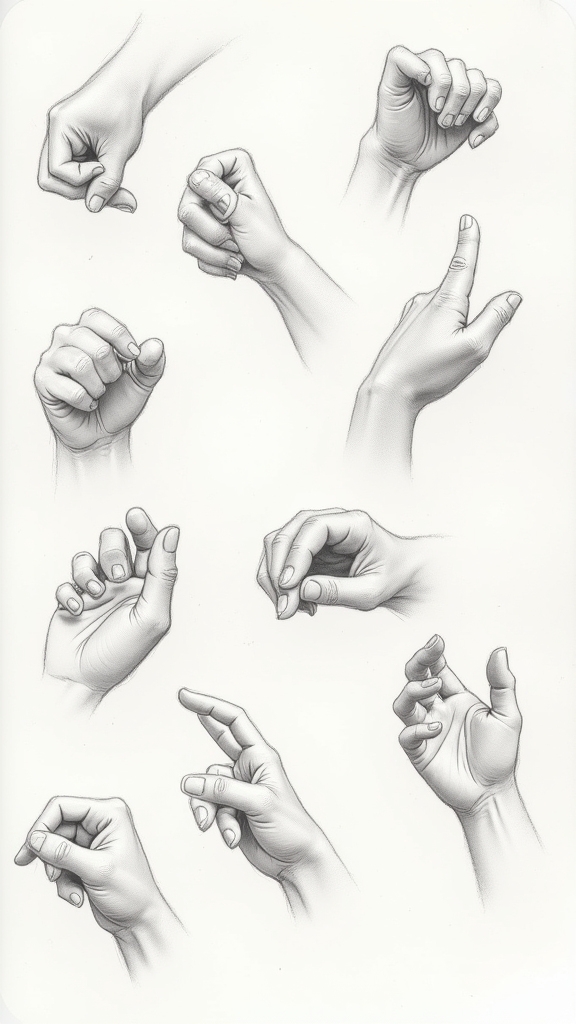
Grab a pencil and take a good look at your own hands—they might seem ordinary, but they’re actually some of the trickiest things to draw! Observing and sketching your hands in lots of different positions is like a mini adventure in hand anatomy exploration.
Try resting your hand, making a fist, or poking at invisible buttons—each pose calls for different shading, linework, and energy. Use gesture drawing techniques to quickly capture the flow and bend of your fingers. Mirrors and phone cameras are your best friends for checking out angles you can’t easily see.
Mix things up with colored pencils for knuckles or add details to fingernails. The more you practice, the more your personal style development will shine through—plus, you’ll have way cooler doodles!
Try Quick Gesture Drawings of People in Motion

Envision this: a person sprints down a sidewalk, arms pumping, sneakers flashing—and all that excitement gets caught on paper in just a few wild, loose lines. That’s what gesture drawing techniques are all about. Instead of sweating every tiny detail, artists use dynamic pose observation to capture movement and energy super fast.
A timer set for just 30 seconds to 2 minutes forces them to trust their eyes and jump right in with spontaneous sketching practice. Don’t worry about mistakes—this is your ticket to making figures look alive instead of stiff as cardboard.
- Sketch at parks, malls, or sports games for real-life motion (plus people-watching is half the fun).
- Keep your pencil moving—wiggly lines are totally cool.
- Turn a sketchbook into a “motion museum” with your favorite action poses!
Depict Your Favorite Food or Drink

Drawing your favorite food or drink is a fun way to practice noticing all the little things, like how a shiny apple looks different from a bubbly soda can.
Try arranging your snacks in a cool way—maybe stack cookies or let spaghetti dangle off a fork—to make the whole picture pop.
Don’t forget to show off your best-loved parts, like the gooey cheese on a pizza or the steam curling up from a mug of cocoa, because those tasty details bring your sketch to life.
Capture Textures and Details
There’s something strangely exciting about trying to sketch your favorite snack or drink—suddenly, that gooey slice of pizza or chilly glass of lemonade becomes an artistic puzzle.
The real secret is in texture exploration techniques. Just think about catching the shine on a melting scoop of ice cream, or the fizz from a soda—every detail matters for realistic food representation! Use detailed shading methods: press lightly for bright spots, and go bolder for those deep, mysterious shadows.
Don’t forget the quirky extras, like a reflection on your soda glass or the tiny seeds on a strawberry. Reference photos can help, but your own style will make things pop!
- Capture how the light bounces off a glistening fruit skin
- Try sketching frothy bubbles on a cappuccino
- Study crunchy, crispy textures like chips
Play With Composition
| Composition Technique | Visual Contrast Idea | Dynamic Arrangement Example |
|---|---|---|
| Overhead angle | Shiny glass vs. table | Drink in foreground |
| Side view | Crumbly crust, smooth cheese | Sliced pizza fanned out |
| Extreme close-up | Bubbles vs. ice cubes | Food scattered off-center |
| Tilted perspective | Wet straw, dry coaster | Layered snack setup |
| Zoomed-out crowd shot | Light vs. shadow slice | Stacked sandwiches |
Showcase Favorite Ingredients
Nothing gets mouths watering and pencils moving quite like sketching a pile of favorite foods or ingredients. When artists plunge into colorful ingredient exploration, they can capture the shine of a cherry or the roughness of a potato just by shading or adding texture.
Trying out mixed media applications—like colored pencils or watercolors—makes food really pop off the page, sometimes so vibrant you almost want to take a bite! Storytelling works its magic too, as culinary storytelling techniques can turn plain onions or lemon slices into the stars of a recipe scene.
- Draw a still life of your favorite fruits and veggies, making colors bold and bright.
- Sketch a dining scene where your top snacks are the main characters.
- Mix pencil with watercolor for zesty, eye-catching results.
Fill a Page With Zentangle Patterns
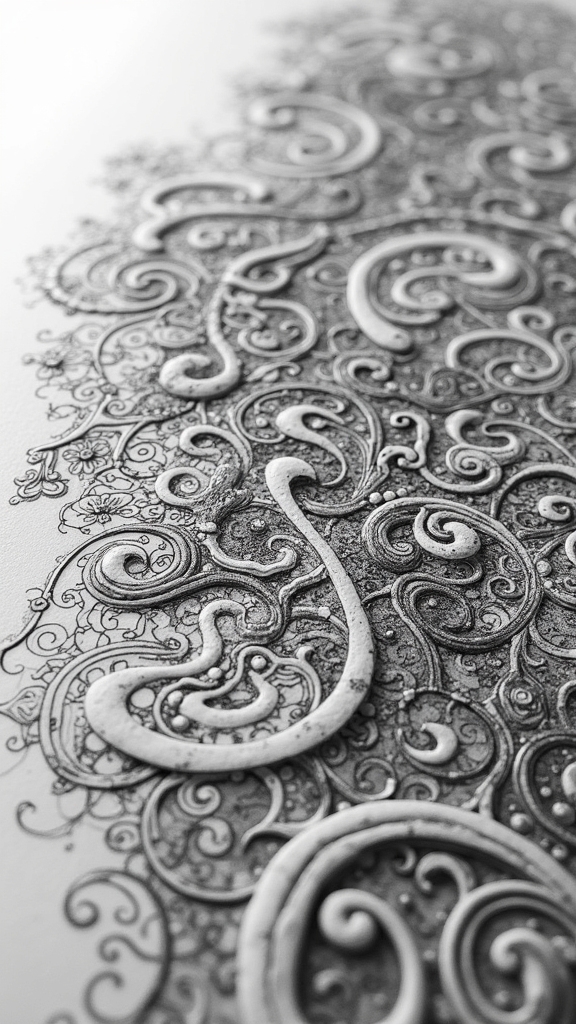
Filling a page with Zentangle patterns can feel a bit like doodling on turbo mode—except, every line, curve, and swirl is part of a bigger, eye-catching masterpiece.
Zentangle techniques turn ordinary pencil sketches into crazy-cool webs of detail, where mindful creation takes center stage. No one has to stress about perfection here. Instead, it’s all about letting pattern experimentation lead the way, mixing swirly lines, wild curves, and sharp geometric shapes into a playground of texture.
Render Architectural Details or Buildings
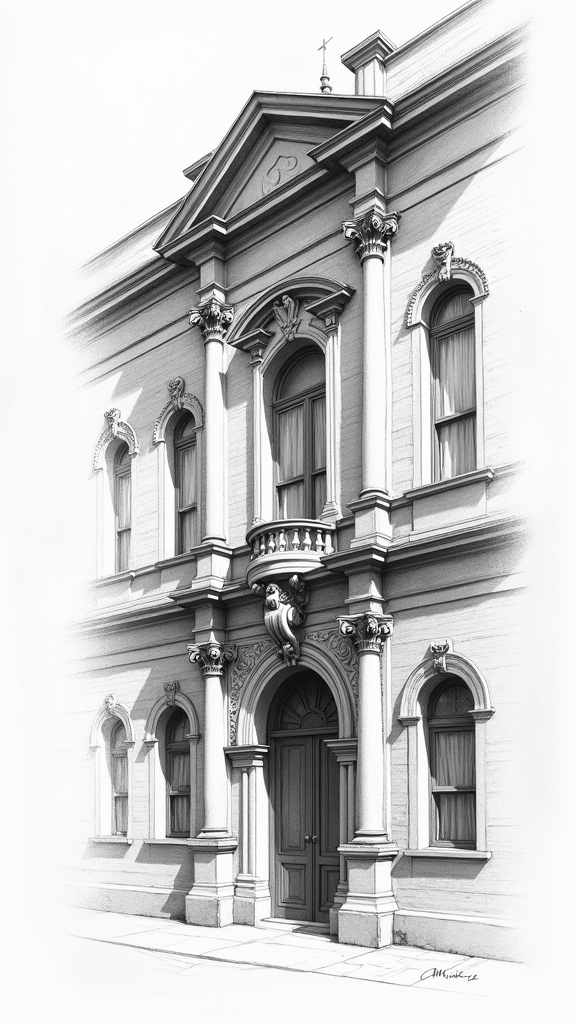
After experimenting with wild Zentangle patterns and letting creativity run loose, sketch artists might feel ready for something a bit more structured—like rendering the real-world drama of buildings.
Jumping into architecture gives drawing sessions a fresh twist: think pointy gothic architecture features, crazy swirling baroque style intricacies, or the sharp, crisp lines of modern design elements. Nothing says “structure” quite like a row of windows or a wobbly rooftop! To make each building leap off the page, pay attention to the unique shapes and textures.
Architecture sketching shakes things up—wobbly rooftops, gothic spires, baroque swirls, and sharp modern lines for extra visual drama.
- Try sketching a spooky old church, focusing on arches and spires to nail those gothic architecture features.
- Draw a fancy baroque palace—swirls, columns, the whole dramatic deal.
- Imagine a city block covered in glass and steel, loaded with modern design elements.
Combine Elements From Multiple Reference Photos
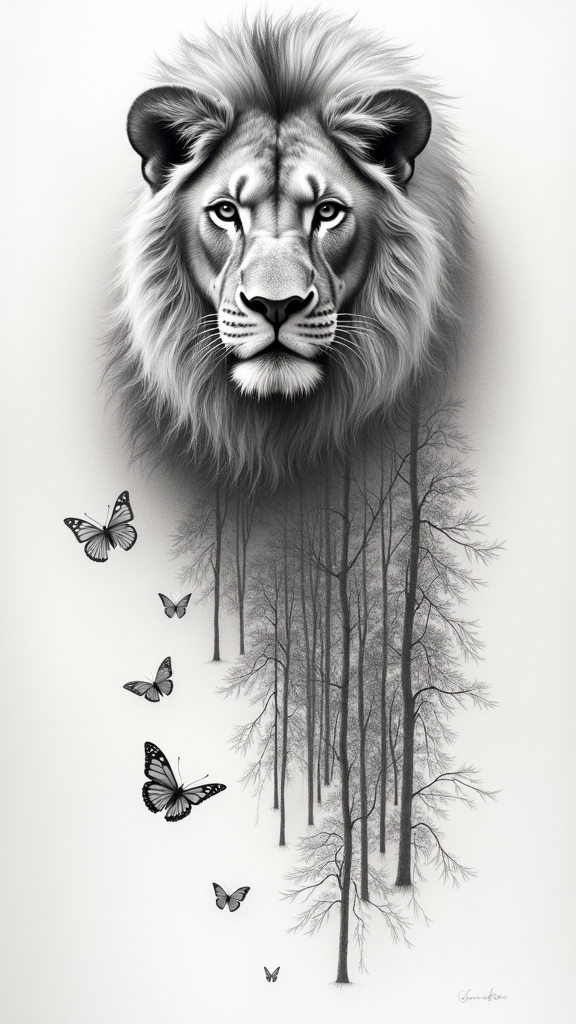
When artists mix and match details from different photos, things can get seriously exciting—the possibilities are almost endless!
With a few smart reference blending techniques, they can build one-of-a-kind pencil sketches that nobody else could dream up. Maybe a tree from one snapshot gets paired with the sky from another, or a building’s windows are reimagined with patterns found somewhere unexpected.
By playing around with creative composition strategies, artists learn to loosen up and let go of copying—this is where real artistic vision development kicks in! Thumbnails help organize wild ideas and keep things from turning into a giant doodle mess.
Plus, experimenting with textures and shapes from all over can lead to fresh, personal designs—and help you grow the kind of style everyone remembers.
Develop Fantasy Creatures or Imaginary Scenes
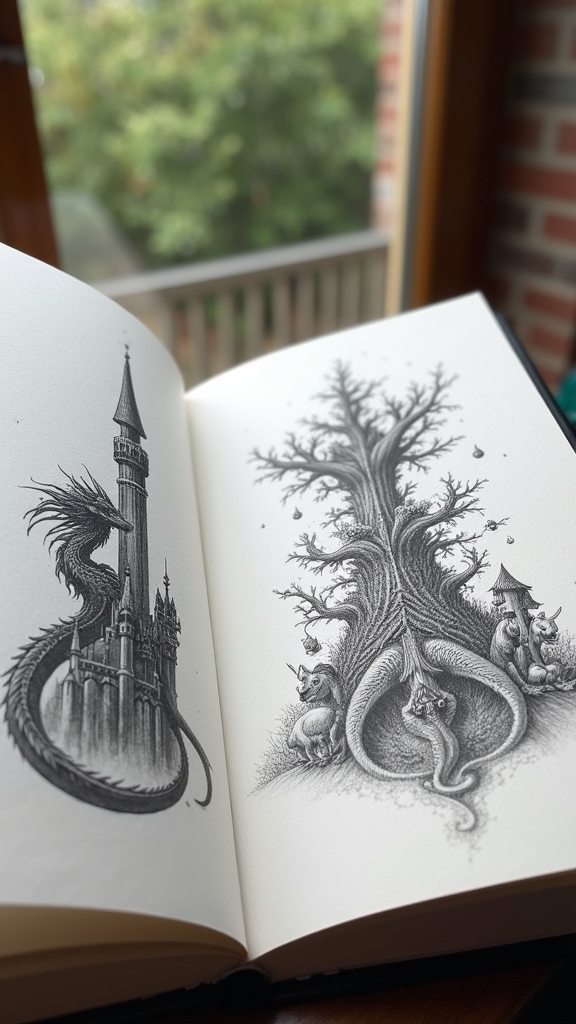
Even though dragons or griffins don’t exactly show up on neighborhood walks, artists can still dream them up with just a pencil and a spark of imagination.
Building mythical hybrids is all about mashing together animal parts, wild ideas, and maybe adding extra horns or wings for good measure. Sketching quick thumbnails lets creators mess around with narrative dynamics—what if a shy, squirrel-tailed unicorn befriends a fiery-eyed wolfbird?
Creature interactions like these bring scenes to life and can tell a whole story in just a doodle. To make fantasy worlds feel real, looking at photos of actual animals or environments can help, but it’s always fun to take those inspirations into pure make-believe.
Try these ideas:
- Mix animals into wild mythical hybrids
- Explore creature interactions in action poses
- Add strong narrative dynamics to scenes
Document Objects of Sentimental Value
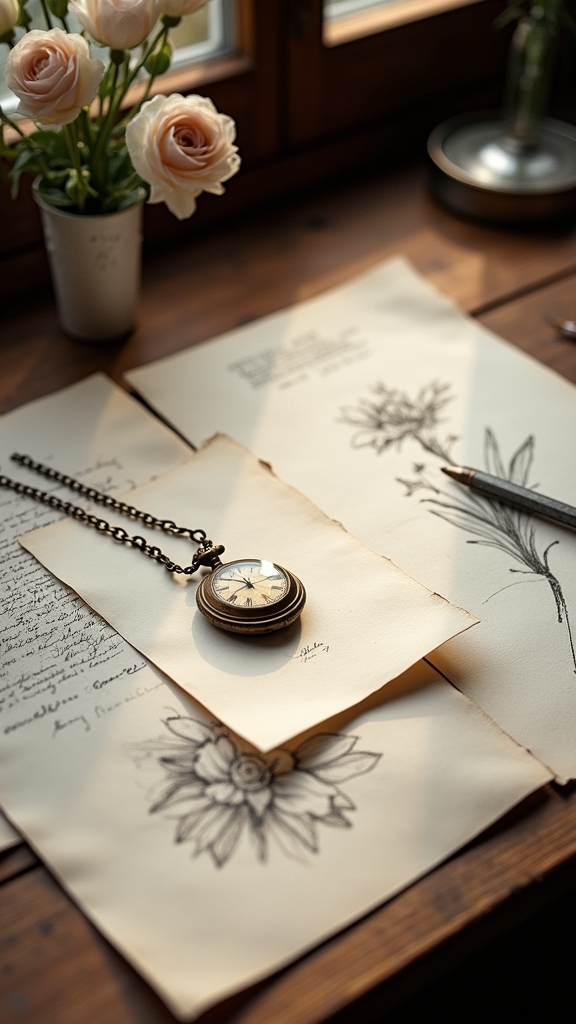
A favorite stuffed animal with matted fur or a lucky keychain that’s been on countless adventures—sketching these sentimental treasures isn’t just about practicing drawing; it’s like building a memory bank on paper.
Sentimental sketches turn regular objects into memory artifacts, each one packed with its own story. Maybe that chipped mug was from Grandma, or the old watch came from a flea market in a city you can barely pronounce.
By drawing cherished heirlooms, focusing on every scratch and faded spot, an artist captures what makes them special. Adding details like the cozy shelf where they’ve always sat can turn sketches into mini-narratives.
Over time, going back and sketching these objects again helps skills improve and memories stay sharp—kind of like free therapy with a pencil!
Draw Seasonal or Weather-Inspired Scenes
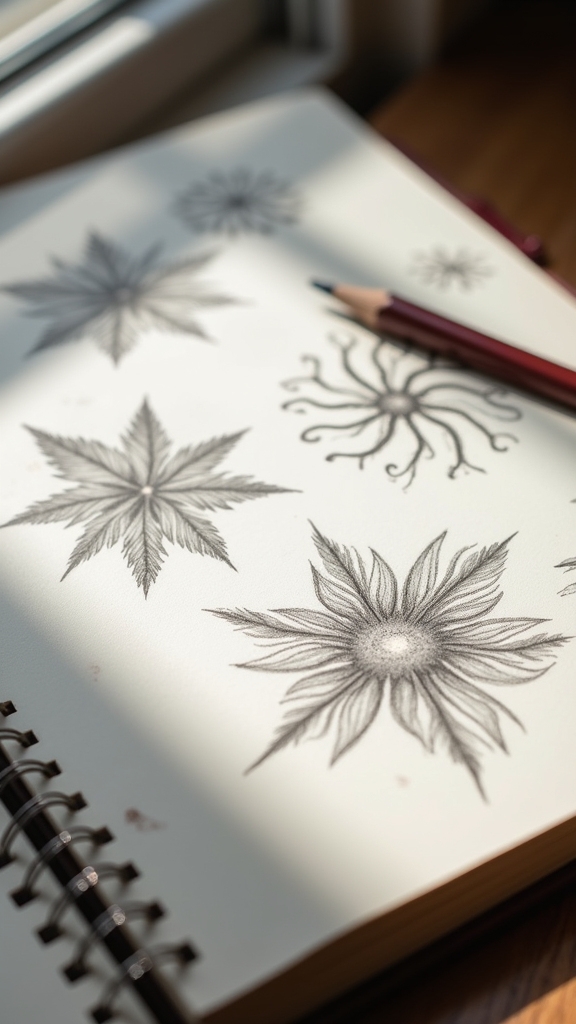
Nothing brings a sketchbook to life like scenes that capture the spirit of a season or the drama of wild weather.
Seasonal contrasts—like crispy autumn leaves versus the hush of winter snow—make for amazing art. When artists sketch weather moods, such as stormy clouds or bright, melting sunlight, it’s a chance to play with shading, texture, and all kinds of creative marks.
Watching scenery changes across the year isn’t just fun—it supercharges observation skills. Try making a series where the same tree or park changes every season. Add details like rainy puddles or blooming flowers to tell a bigger story.
- Draw a summer beach, then redraw it in winter for a surprising twist.
- Capture moody skies with swirling clouds.
- Sketch a garden blooming, then covered in snow.
Frequently Asked Questions
How Do You Fill a Sketch Page?
To fill a sketch page, one might explore various sketch techniques, arrange interesting page layouts, and use drawing prompts for inspiration. Integrating geometric shapes, patterns, and environmental observations can help create visually engaging and cohesive sketchbook compositions.
What Can an 11 Year Old Draw?
An 11-year-old can draw cartoon characters inspired by their favorite shows, vibrant nature scenes including trees or animals, and imaginative fantasy creatures. These subjects encourage creativity, skill development, and personal expression suited to a young artist’s interests.
What to Draw 100 Ideas?
The current question explores inspiration sources, suggesting individuals consider drawing nature scenes, geometric patterns, and character sketches. By diversifying subjects, artists can generate 100 unique ideas, ranging from detailed vistas to abstract designs and imaginative human portraits.
What Can I Draw in 5 Minutes?
For those wondering what can be drawn in five minutes, quick doodle prompts, simple shape sketches, or fast character designs offer enjoyable options. Sketching from surroundings or creating zentangles also provides creative inspiration within this short timeframe.
Conclusion
Wow, who knew a simple pencil could open so many creative doors? With these sketch ideas, anyone can turn boring notebook pages into cool art—no magic powers required. Whether drawing your favorite mug or inventing alien turtles, each sketch is a chance to discover something new. So sharpen that pencil, trust your imagination, and seriously—don’t stress about perfection. Real artists make mistakes, laugh about them, and keep going. Grab your sketchbook, and have fun filling those pages!

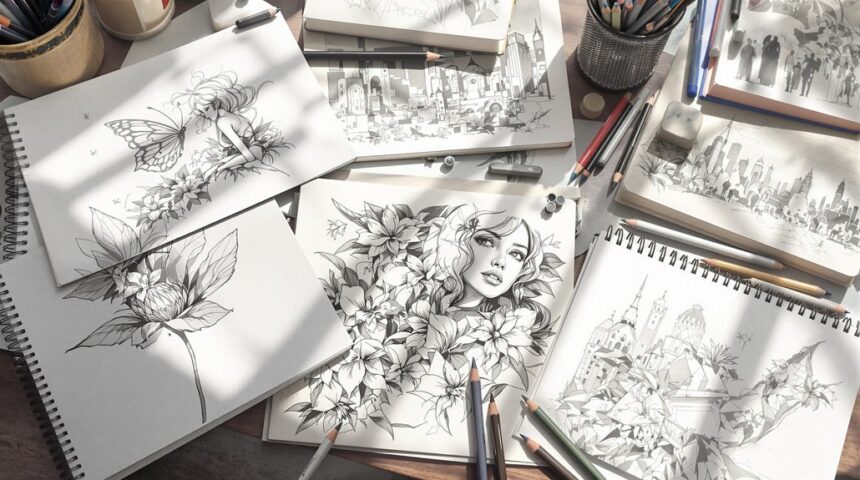
Leave a Reply